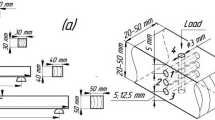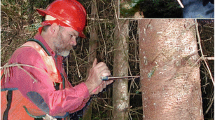Abstract
Density values are essential for the characterization of wood elements in existing structures. A new method for the in-situ density estimation of timber pieces is proposed based on weighting the residue generated by conventional drilling. This research includes the design and development of a residue collector device coupled to a conventional drill and testing on four Spanish coniferous species: Laricio pine, Scots pine, Radiata pine and Maritime pine (Pinus nigra Arn., Pinus sylvestris L., Pinus radiata D. Don. and Pinus pinaster Ait., respectively). For each species, 44 specimens (except Scots pine, with 42) 60 × 90 mm cross-section and 150 mm length (half radial and half tangential orientation) were tested. Specimen density was obtained by mass/volume ratio. Three 8 mm diameter 46.5 mm deep holes were drilled in each specimen using a brad point bit. The drilling residue was weighed and density was calculated as a ratio to bore volume. Although only slightly smaller, residue density statistically differs from average specimen density. But the specimen density can be inferred by the correlation, statistically significant, with residuals drilling density (R2 = 80.7%) and even better with residual drilling mass (R2 = 84.4%).









Similar content being viewed by others
References
Acuña L, Basterra A, Casado MM, López G, Ramón-Cueto G, Relea E, Martínez C, González A (2011) Application of resistograph to obtain the density and to differentiate wood species. Materiales de Construcción 61(303):451–464
Arriaga F, García L, Gebremedhin KG, Peraza F (1992) Grading and load carrying capacity of old timber beams. International Summer Meeting, American Society of Agricultural Engineers, ASAE. Charlotte, North Carolina, USA
Arriaga F, Peraza F, Esteban M, Bobadilla I, García F (2002) Intervención en estructuras de madera (Intervention in existing timber structures). Ed. Aitim, Madrid
Arriaga F, Esteban M, Íñiguez-González G, Bobadilla I, Llana DF, González-Sanz M (2013) Structural assessment of the timber structure of the Casa Grande building in the Real Cortijo de San Isidro, Aranjuez, Madrid (Spain). In: Proceedings of 18th International Nondestructive Testing and Evaluation of Wood Symposium. General Technical Report FPL-GTR-226. U.S. Department of Agriculture, Forest Service, Forest Products Laboratory, Madison
Bethge K, Mattheck C, Hunger E (1996) Equipment for detection and evaluation of incipient decay in trees. Arboric J 20:13–37
Bobadilla I, Iñiguez G, Esteban M, Arriaga F, Casas L (2007) Density estimation by screw withdrawal resistance and probing in structural sawn coniferous timber. In: Proceedings of the 15th International Symposium on Nondestructive Testing of Wood. Duluth
Bobadilla I, Iñiguez G, Arriaga F, Esteban M (2009) Técnicas no destructivas en la inspección de estructuras de madera I: El penetrómetro (Nondestructive techniques in the assessment of timber structures I: the penetrometer). BIT AiTiM 260:66–70
Bobadilla I, Martínez R, Calvo J, Arriaga F, Iñiguez-González G (2013) First steps in wood density estimation using a conventional drill. In: Proceedings of the 18th International Symposium on Nondestructive Testing of Wood. Madison, Wisconsin
Brashaw BK, Vatalaro RJ, Wacker JP, Ross RJ (2005) Condition assessment of timber bridges. Evaluation of a micro-drilling resistance tool, General Technical Report FPL—GTR—159. Forest Products Laboratory, US Department of Agriculture
Bucur V (2006) Acoustic of wood. Springer, Berlin
Cai Z, Hunt MO, Ross RJ, Soltis LA (2002) Screw withdrawal—a means to evaluate densities of in-situ wood members. In: Proceedings of the 13th International Symposium on Nondestructive Testing of Wood. Berkeley, California
Calderoni C, De Matteis G, Giubileo C, Mazzolani FM (2010) Experimental correlations between destructive and non-destructive tests on ancient timber elements. Eng Struct 32(2):442–448
Divos F, Tanaka T (1997) Lumber strength estimation by multiple regression. Holzforschung 51(5):467–471
Esteban M, Bobadilla I, Arriaga F, Íñiguez G, García H (2009) NDT applied to estimate the mechanical properties of the timber of an ancient structure in Valsaín, Segovia (Spain). In: Proceedings of the 16th International Symposium on Nondestructive Testing of Wood. Beijing Forestry University, pp 152–157
Falk RH, DeVisser D, Plume GR, Fridley KJ (2003) Effect of drilled holes on the bending strength of large dimension Douglas-fir lumber. For Prod J 53(5):55–60
Íñiguez-González G, Montón J, Arriaga F, Segués E (2015) In-situ assessment of structural timber density using non-destructive and semi-destructive testing. BioRes 10(2):2256–2265
Jasieńko J, Nowak T, Hamrol K (2013) Selected methods of diagnosis of historic timber structures—principles and possibilities of assessment. Adv Mater Res 778:225–232
Kasal B (2003) Semi-destructive method for in-situ evaluation of compressive strength of wood structural members. For Prod J 53:55–58
Kasal B, Anthony R (2004) Advances in in situ evaluation of timber structures. Prog Struct Eng Mater 6(2):94–103
Kloiber M, Kotlínová M (2006) Prediction of mechanical properties by means of radial cores in situ, NSF/MŠMT supported US-Czech project and RILEM Workshop. In-Situ Evaluation of Historic Wood and Masonry Structures, Prague
Mariño R, Fernandez ME, Fernández C (2002) Análisis comparativo de la densidad de la madera de Pinus sylvestris L. mediante la utilización del resistógrafo (Comparative analysis of the density of Pinus sylvestris L. timber using a resistograph). Revista CIS-Madera 9:60–70
Martínez R, Bobadilla I (2013) Extractor de muestras de madera mediante taladro (Wood sample extractor using a conventional drill). Spain, ES2525504. (B27C 3/00) (2006.01), 16 Nov 2015. Appl. 201330890, 14 Jul 2013
Monton J (2012) Clasificación estructural de la Madera de Pinus radiata D. Don procedente de Cataluña mediante métodos no destructivos y su aplicabilidad en la diagnosis estructural (Structural Classification of Pinus radiata D. Don timber from Catalonia by non-destructive methods and their applicability to structural assessment). Thesis Doctoral. UPC, pp 102–110
Pellerin RF, Ross RJ, Beall FC, Bradshaw BK, Cheung K, Wang X (2002) Nondestructive evaluation of wood. Forest Products Society, Madison
Rinn F (2012) Basics of typical resistance-drilling profiles. West Arborist Winter:30–36
Ross RJ, Pellerin RF (1994) Non destructive testing for assessing wood members in structures: a review. USDA Forest Service, Forest Products Laboratory, FPL-GTR-70, Madison, pp 1–40
Ross RJ, Soltis LA, Otton P (1998) Assessing wood members in the USS Constitution using non-destructive evaluation methods. APT Bull J Preserv Technol 29(2):21–25
Soriano J, da Veiga NS, Martins IZ (2015) Wood density estimation using the sclerometric method. Eur J Wood Prod 73(6):753–758
Tippner J, Kloiber M, Hrivnák J (2011) Derivation of mechanical properties by pushing of a pin into wood. In: 17th International nondestructive testing and evaluation of wood symposium, Sopron, pp 575–582
UNE-EN: 13183-1 (2002) Moisture content of a piece of sawn timber. Part 1: Determination by oven dry method. Asociación Española de Normalización y Certificación (AENOR), Madrid
Acknowledgements
Ministerio de Economía y Competitividad, Programa Estatal I + D, 2013–2016, Proy.: BIA2014-55089-P. Asociación de Investigación Técnica de la Madera (AiTiM), Proy.: AiTiM-Fucovasa 2012-13.
Author information
Authors and Affiliations
Corresponding author
Rights and permissions
About this article
Cite this article
Martínez, R., Calvo, J., Arriaga, F. et al. In situ density estimation of timber pieces by drilling residue analysis. Eur. J. Wood Prod. 76, 509–515 (2018). https://doi.org/10.1007/s00107-017-1214-7
Received:
Published:
Issue Date:
DOI: https://doi.org/10.1007/s00107-017-1214-7




